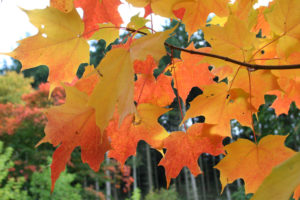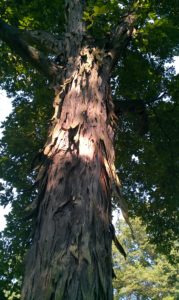In our last “Field Notes”, Lee discussed the benefits of shade trees. Now I would like to mention just a few of my favorites in case you are planning to add one to your own landscape.
At the top of my list is the Quercus alba, or White Oak. This is truly a tree that you plant for your grandchildren. As trees go, nothing is statelier than an oak which can ultimately grow to 100’ or more. With spreading branches and a rounded crown, the White Oak is a majestic tree, and would be appropriate for almost any yard that has room for it to grow. White Oaks have the reputation for being slow growing, but you will be amazed at how large an oak can grow in just several years.
Besides their beauty, another benefit to oaks is their habitat value. Squirrels, turkey, cottontail rabbits, blue jays, and other animals eat the acorns, and over 530 species of caterpillars feed on their leaves. This means that you are certain to see song birds such as warblers flitting among the branches in the spring, hunting for a quick meal to feed their young. I remember watching brown creepers climbing up the trunk of a large oak out my back window, while red breasted nuthatches start at the top and work their way down. This ensures each bird species will find the insects that the other one has missed. Don’t worry that these insects may damage the tree; with all of the bird activity, the insect populations are sure to remain in check.
White Oak foliage turn russet to wine in autumn and when the leaves drop, the wonderful architecture of the branches is revealed for the winter months.
Another top pick for shade trees is the Acer saccharum, or Sugar Maple. Maples can also grow quite large, at 60-75’. While White Oaks turn russet in autumn, Sugar Maples are unrivaled when it comes to fall color, and can turn from red to yellow, with orange being the most dominant color. A large Sugar Maple ablaze with color on a clear fall day can be a vision that takes your breath away.
Besides the fall color, Sugar Maples have other benefits. The fruit, called samaras, are eaten by numerous animals including finches, chipmunks and bobwhite quail. Samaras are also fun! They are basically a seed with wings that spin like helicopter blades as they fall to the earth. They also make great Pinocchio noses when split apart at the end and placed on the tip of your nose.
In addition to the fruit, Sugar Maples produce maple syrup. Their sap is very sweet, and when boiled down, it becomes thick and syrupy. Although not complicated, it does take 40 gallons of sap to make 1 gallon of syrup. This will not hurt the tree, so maple sugaring can be done every year. If you do decide to try maple sugaring, I will pass along some advice from our Uncle Ellie: Don’t leave the boiling sap unattended. Coming home to masses of sticky sap which had boiled over onto the stove and kitchen floor can be quite a surprise, and quite a project!
If oaks and Sugar Maples are simply too large for your site, consider a Nyssa sylvatica, or Black Gum. Nyssa sylvatica may eventually reach 30-50’ high, but it will take a while getting there since the growth rate of these trees is slow to moderate. Along with the manageable size, Black Gum has plenty going for it. It is a beautiful tree, pyramidal in shape while young, and often spreading with age. It has simple, deep green, lustrous leaves that grow 3-6” long, and is one of the most consistent trees for fall color. Color may vary from yellow and orange to red and purple. I can still picture a collection of Black Gum in screaming red fall color as I pulled into Longwood Gardens. It made quite a statement at the entrance of this world-renowned garden.
In addition to the wonderful ornamental value of this tree, Nyssa sylvatica has a very high wildlife value. It produces small, dark blue to black fruit that ripen in September-October. The fruit is eaten by a variety of birds including thrushes, blue jays, woodpeckers, cedar waxwings, and scarlet tanagers.
So if you are looking for a moderately sized shade tree with great form, nice summer foliage, incredible fall color, and high habitat value, maybe a Black Gum is for you.
Another shade tree worth considering is the dramatic, Carya ovata, or Shagbark Hickory. Like the name implies, the Shagbark Hickory’s bark grows in rough plates, which hang from the tree, giving it a very shaggy appearance. It has an irregular, oblong crown which adds to its interest. Although Shagbark Hickories can grow 60-80’ or taller, they must be planted while quite small because of a deep tap root. Once they get going, they are well worth the wait.
The shaggy bark is a great hiding place for a variety of insects, and therefore a great place for birds to hunt for dinner. Hickories also produce hickory nuts which feed numerous animals such as rabbits, squirrels, wood ducks, and wild turkey. Related to pecans, nuts from hickories can be sweet or bitter. The nuts from Carya ovata are of the sweet variety, and although they have a reputation for being difficult to remove from the shell, they can be collected and eaten raw, roasted, or baked in recipes.
Besides the interesting bark and the nuts, hickories have great fall color, and the Shagbark Hickory is no exception. The clear golden yellow leaves provide great contrast against the dark, shaggy bark.
The last shade tree that I would like to recommend is Gymnocladus dioicus, or Kentucky Coffeetree. A coarse tree with very thick stems, the Kentucky Coffeetree is a great tree for architectural interest in winter. As the tree leafs out in late spring, it forms compound leaves that provide a soft, filtered shade.
As the botanical name implies, Gymnocladus dioicus is dioecious, meaning that there are separate male and female plants. The female trees produce a dark pod, which contains several dark, round seeds. Also as the name implies, those seeds were used by settlers to make coffee. It has been reported that these seeds are poisonous to humans and livestock, and that roasting them may destroy these toxins. In any case, I would not recommend planting Kentucky Coffeetree for use as a coffee substitute.
Kentucky Coffeetree grows 60-75’ high, has variable, yellow fall color, and is a picturesque tree in all seasons.
As always, it is very important to choose plants appropriate to each site, especially when selecting shade trees. The above is only a short list of wonderful native shade trees from which to choose. The staff at GreenWeaver is passionate about native trees, so if you would like advice on which tree would best fit a particular site, or would like ideas for other alternatives, feel free to contact us!






